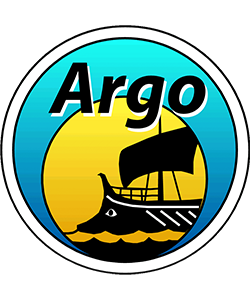 Argo is a global array of ~4000 free-drifting instruments, spaced about every 3° of latitude and longitude, moving up and down in the water column from the sea surface to 2000 meters every 10 days, and profiling temperature, salinity, and depth during every ascent to the surface. Argo provides the first-ever global-scale, all-weather subsurface real-time observations of the oceans. This achievement is a triumph of international collaboration and the generous agreement of Coastal States to allow Argo to operate within their waters. While sustaining present Argo temperature and salinity observations in the upper 2000 meters, BGC Argo floats carry extra sensors to measure biogeochemical variables, and Deep Argo floats sample far below 2000 meters to the ocean bottom. Note that the only parameters approved by Coastal States that Argo floats can measure within their waters include pressure, temperature, salinity, oxygen, nitrate, pH, chlorophyll-a, suspended particles, and downwelling irradiance. Non-Argo floats do not have this clearance (See below).
Argo is a global array of ~4000 free-drifting instruments, spaced about every 3° of latitude and longitude, moving up and down in the water column from the sea surface to 2000 meters every 10 days, and profiling temperature, salinity, and depth during every ascent to the surface. Argo provides the first-ever global-scale, all-weather subsurface real-time observations of the oceans. This achievement is a triumph of international collaboration and the generous agreement of Coastal States to allow Argo to operate within their waters. While sustaining present Argo temperature and salinity observations in the upper 2000 meters, BGC Argo floats carry extra sensors to measure biogeochemical variables, and Deep Argo floats sample far below 2000 meters to the ocean bottom. Note that the only parameters approved by Coastal States that Argo floats can measure within their waters include pressure, temperature, salinity, oxygen, nitrate, pH, chlorophyll-a, suspended particles, and downwelling irradiance. Non-Argo floats do not have this clearance (See below).
The Argo Steering Team (AST) provides scientific leadership and oversees the development and operation of the program, implemented by national and regional Argo projects, under a set of best practices which include:
- Adherence to the framework for entry into the Argo data stream
- International coordination of deployments
- Float registration at OceanOPS (including deployment plans, official and advanced deployment notifications to Argo National Focal Points, parameters measured and other metadata)
- Respect of coastal states rights over their Exclusive Economic Zones (UNCLOS, IOC/UNESCO Resolution XX-6 and EC-XLI.4). Transparency around what is measured where is paramount.
- Harmonized practices in sampling, cycling, data and metadata collection and distribution, to realize a global data set of uniform sampling.
- Free and unrestricted real-time data sharing through the Global Telecommunication System (GTS) and Global Data Assembly Centre (GDAC)
- Adoption of agreed upon data timeliness, formats, quality control procedures and maintenance, to ensure a global data set of uniform and known quality.
- Careful securing and retrieval of beached instruments, to ensure the safety of the public and environment. Argo floats carry a specific label for this purpose.
The international Argo community, the Argo Program Office (argo@ucsd.edu), and the OceanOPS Centre (support@ocean-ops.org) can provide day to day assistance to Argo float deployers, including:
- Clearing house for information
- Overall assistance and mediation
- Guidance on intergovernmental issues
- Monitoring web-based tools and services
- On demand reporting tools, statistics, and maps
- Deployment and retrieval opportunities
The AST welcomes new float deployments if they align with Argo’s missions. Contributions from research projects may be welcome even if they do not strictly comply with all Argo sampling, drifting or cycling strategies, and spatial distribution targets. Please contact your National Argo Steering Team member, OceanOPS, or the Argo Program Office to learn more.
The AST reserves the right of use of the official Argo label. In particular, registration done after deployment date will be subject to careful review by the AST exec. and might not be accepted.
Use of Non-Argo Profiling Floats for research and other applications:
Not all profiling floats can, or should be, part of Argo. If the requirements of the Argo Program do not align well with your needs, or you are unable to meet Argo’s transparency, data sharing, operational and data management requirements, research profiling floats should be deployed outside of the Argo Program.
Floats outside of Argo need to follow different rules for deployments and permission/clearance procedures if they have the potential to drift into EEZs. Please see the table below to ensure you are abiding by international legal agreements, whether your float is part of the Argo Program or it outside of it. Any questions around these guidelines can be sent to support@ocean-ops.org
| Deployment in High Seas | Deployment into an EEZ | Drifting into an EEZ | Drifting into another EEZ | |
| Argo | e-notification in advance (such as a deployment plan) | e-notification + MSR clearance with some exceptions | Nothing, except: bilateral notification as requested by 12 member states | Nothing, except: bilateral notification as requested by 12 Member States |
| Non-Argo | No guidelines | MSR clearance 6 months in advance of the operation | MSR clearance 6 months in advance of the operation | MSR clearance 6 months in advance of the operation |
Download this information as a pdf.
